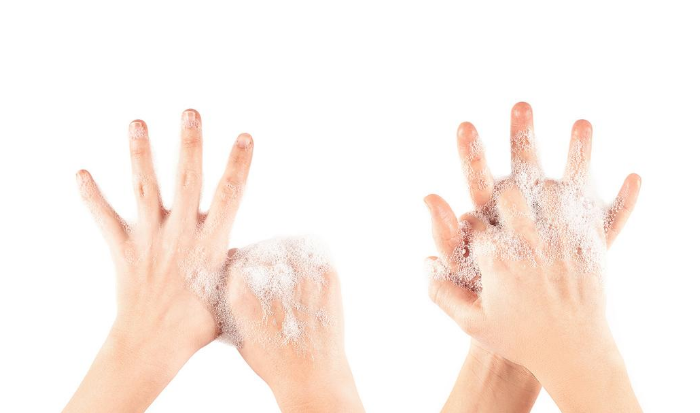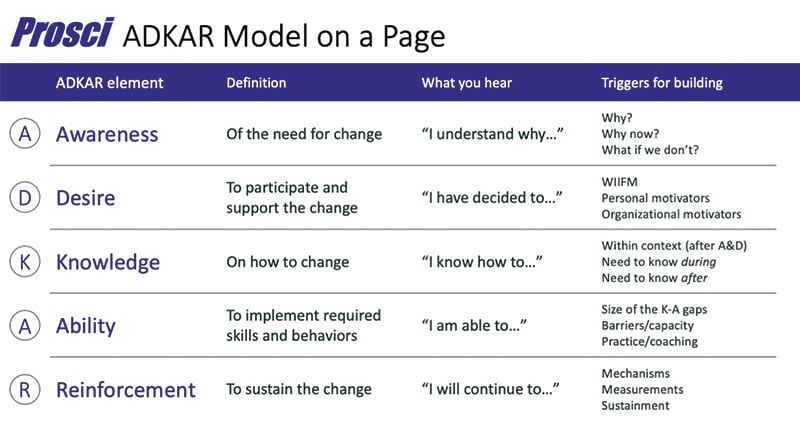Use the ADKAR Model to Reinforce Handwashing Behaviors

3 Mins
Updated: February 23, 2024
Published: August 12, 2020

By now, most people understand the importance of handwashing to avoid contracting and spreading COVID-19. As a nurse, I have seen handwashing behaviors curb virus transmission significantly. As a change practitioner, I see the need for focused reinforcement as we return to our workplaces. As workplaces re-open and life begins to feel a bit more “normal,” it’s likely that our attention to handwashing will diminish. Applying the ADKAR Model can help employees stay focused on proper handwashing and other behaviors that contribute to keeping everyone safe.
Handwashing and the ADKAR Model
When changing any behavior that is critical to success, the Prosci ADKAR Model comes to mind. A research-based and goal-oriented model that guides both individuals and organizations, the ADKAR Model comprises five building blocks for successful change: Awareness, Desire, Knowledge, Ability and Reinforcement.
Here’s what the change to proper handwashing behaviors looks like through the ADKAR lens and what your organization can do to promote and continually reinforce it.
Awareness of the need for change
Because one of the known modes of COVID-19 transmission occurs through hand-to-face contact, effective handwashing is a critical behavior. At the start of the pandemic, news updates featured healthcare officials stressing the importance of hand washing as an effective tactic for preventing infection. When individuals first received this information, they were working through Awareness, the first element of the ADKAR Model.
Your organization can increase Awareness of the need for proper handwashing by asking employees what you can do to help. You can talk to managers about fulfilling their important role as trusted communicators about the change. Consulting with thought leaders and informing yourself with credible information is also important, especially now, because people are overwhelmed with too much information. To remedy this, rely on one reputable source, such as the Centers for Disease Control.
Desire to support the change
As a prevention approach, handwashing is inexpensive and relatively easily to implement. Why then, is it necessary to continue to stress the importance of practicing good hand hygiene? Because being aware of the need for handwashing does not automatically create the Desire to support the behavior change.
Organizations can in increase Desire for handwashing by understanding why a person likes or dislikes the change because this affects their willingness to adopt it. When faced with a change, individuals first ask, “What’s in it for me?” This makes addressing Desire tricky. You don’t know what triggers someone to change because individuals are unique. Information, goals and life circumstances all influence Desire.

Knowledge of how to change
That brings us to the next ADKAR element: Knowledge. Do individuals truly know how to wash their hands effectively? I’m inclined to say that most people do not, as evidenced by the various techniques I’ve witnessed in public restrooms:
- No wash
- Rinse and shake
- 5-second, no-soap scrub
- 5-second scrub with soap
- 15-second scrub with soap
- The 20- to 30-second scrub with soap
The only effective and recommended method is the 20- to 30-second scrub with soap. Singing the Happy Birthday song in your head as you wash helps you understand just how long it should take. Individuals also need to be taught that the thumbs and wrists, crevices between fingers, and spaces under rings and nails need extra attention. If you don’t have access to soap and water, hand sanitizer with 60% or greater alcohol content is a decent substitute. All this information contributes to an individual’s Knowledge of how to change.
Organizations can increase Knowledge of how to adopt proper handwashing by providing information and resources employees need, such as instructions, training and platforms. Make sure they’re ready and available when people are ready to learn because Knowledge is critical to moving on to Ability.
Ability to demonstrate skills and behaviors
The fourth element of the ADKAR model is Ability. People must be able to wash their hands effectively. Hand soap is available in ample supply, but hand sanitizer can be harder to find or prohibitively expensive for some. This creates a challenge for keeping hands clean when you’re on the move and away from a sink and soap. Because of this, it’s important to understand that people may have a barrier to Ability when going through this change.
Your organization can increase Ability by removing barriers related to time, effort, energy, and physiological and psychological issues. Give people the time and permission to learn proper handwashing techniques. Provide hand sanitizer as needed. Understand individual fears, stresses and anxieties. Leaders and managers must understand people and decide as an organization if you will accommodate their issues with handwashing requirements, and if so, how.
Reinforcement to make the changes stick
The fifth and final element of the ADKAR Model is Reinforcement. How do you make this handwashing behavior change stick? Healthcare research shows that as clinicians get busier, their diligence with hand hygiene practices declines. As life normalizes and you return to your busy routine, it’s likely that your hand hygiene practices will drop off as well. The hand hygiene police will not be checking on you, which makes this a perfect opportunity for self-reinforcement. To maintain the change, you must monitor and reward yourself for practicing good hand hygiene throughout your busy day. In the long run, the reward will come as decreased transmission of COVID-19, flu and colds. And you can take pride in doing your part to keep yourself and others healthy.
Your organization can reinforce and sustain handwashing behaviors by promoting self-reinforcement, offering genuine acknowledgements, and celebrating successes. Ongoing communication, collecting feedback through surveys, tracking fluctuations in behaviors, and generally engaging with people on the topic of hand hygiene will also help.
Change Happens One Individual at a Time
To keep COVID-19 from surging to threatening levels in your area, individuals must continue to adopt, use and maintain proper handwashing behaviors. And as society continues to re-open, keeping people and organizations free from COVID-19 outbreaks will take vigilance. Fortunately, applying the ADKAR Model is an easy and effective way to help your people through this and any other meaningful change.
Did you find this content helpful? If so, please share it!


